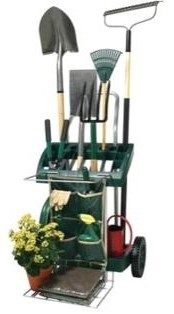
You can grow an abundant harvest with some timely garden care. All you need to do is arm yourself with a few basic tools, a bit of time and regular visits to the garden throughout the growing season to keep plants healthy and more productive.
You do not need to invest in every garden tool on the market. A shovel, trowel, weeding tool, gloves and kneeling pad are the basics. If your budget is tight, ask gardening friends and family if they have extras to spare or lend.
Now you are ready to get started. Weed control is an ongoing task. Working in a few minutes of weeding time as your schedule allows makes this a much less overwhelming task versus trying to week your entire garden at once. Keep a bucket with your favorite weeding tool, gloves, and kneeling pad by the door. Anytime you have a few minutes between other activities pull a few weeds.
If tools are handy, you spend less time looking for them and more time accomplishing the task. Consider keeping all your tools conveniently stored and ready for the garden in a mobile storage caddy. Most models have room for short and long handled tools, a bucket for gathering weeds plus wheels and a handle for easy maneuvering.
Spread a layer of shredded leaves, evergreen needles or other organic matter over the soil surface surrounding your vegetable plants. This layer of organic matter helps conserve moisture so you will need to water less often. It also helps suppress weeds and improves the soil as it decomposes.
As your seeds sprout and begin to grow, you will need to do a bit of thinning. Remove extra plants, leaving enough space for those remaining seedlings to reach full size. The seed packet recommends the proper spacing for the vegetables you planted. Some seedlings like radishes, beets and spinach are edible so think of this as harvesting instead of throwing them away.
Once you make your first harvest, and have available space in the garden, fill it with another planting. Succession, also called relay planting, allows you to grow several different vegetables in the same space. Just make sure the second planting has time to reach maturity and produce before the end of the growing season. Seed packets and plant tags contain information on the number of days from planting to harvest. Compare this to the number of days until the average first fall frost.
Keep plants healthy with proper watering and fertilization. Water new plantings often enough to keep the top few inches of soil slightly moist. Wait until the top few inches of soil are crumbly and moist to deeply water established plants. Deep watering, moistening the top six inches of soil, encourages plants to develop a more drought resistant root system. Frequent shallow watering keeps roots near the soil surface where they dry out quickly and insufficient water means fewer and smaller vegetables.
Follow soil test recommendations for fertilizing your plants. If these are not available, consider using a fertilizer recommended for vegetable gardens. Apply it according to the label directions. Do not overfertilize your garden. Too much fertilizer can cause more problems in plants than not enough.
Providing plants with space to grow and keeping them healthy means fewer insect and disease problems. That means a bigger harvest for you and your family to enjoy all season long.
Melinda Myers has written numerous books and hosts How to Grow Anything DVD series and the nationally syndicated Melinda’s Garden Moment TV & radio program. Her website is MelindaMyers.com.
Related Articles & Free Email Newsletter
Greenhouse Gardening for Beginners
How to Get Started with Organic Gardening in a Greenhouse




Comment here